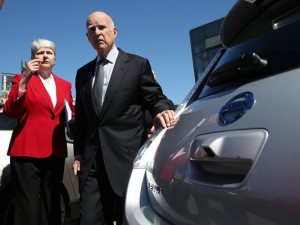 This past Friday in Sacramento, the Office of California Governor Jerry Brown convened a few hundred electric vehicle experts for an update on California’s progress deploying EVs. The attendees were mostly from California, including utility representatives, advocates, researchers, and officials. However, experts also came from places ranging from Oregon to the Netherlands. Some informational highlights from the conversation:
This past Friday in Sacramento, the Office of California Governor Jerry Brown convened a few hundred electric vehicle experts for an update on California’s progress deploying EVs. The attendees were mostly from California, including utility representatives, advocates, researchers, and officials. However, experts also came from places ranging from Oregon to the Netherlands. Some informational highlights from the conversation:
- The Netherlands recently reached a major milestone: 25% of their new car sales were electric vehicles. Part of the appeal: the Netherlands waived the sales tax on EVs and has invested heavily in charging stations. Maybe a good lesson for California as EV rebate money runs out? Waiving the sales tax on EVs, if it could pass the Legislature, would be a great incentive for purchase.
- Most Nissan LEAF, Chevy Volt, and Toyota Plug-In Prius customers were motivated by the environmental benefits and fuel savings. Tesla customers, however, were primarily motivated by vehicle performance and access to new technology. Survey results found here (collected by the entity that sends out vehicle rebates, which is a great source of market data like these).
- Most electric vehicle customers skew to the older, whiter, more highly educated, and male demographic.
- HOV (carpool) lane access was an “extremely or a very important purchase motivation” for 59% of EV customers. This bodes poorly for California as the state is running out of carpool lane stickers to distribute — like in a matter of months. The Governor’s Office vowed to make addressing this need a priority.
- California sales of EVs currently represent one-third of the national market, with 64,649 sold to date. The sales graph is definitely looking like a hockey stick, which is an incredible advance for the technology.
- An electric utility rep says that sales of California’s low carbon fuel credits could mean $200 a year back in the pockets of EV drivers. The low carbon fuel standard is part of California’s efforts to reduce greenhouse gas emissions to 1990 levels by 2020, and it requires fuel refiners to either limit the carbon content of their fuel or purchase credits on the open market. Since electric utilities are providing low-carbon fuel (electricity) to their EV customers, the utilities get to sell the credit to oil companies and then return the money to the EV drivers. And if the utility is saying $200 a year, it’s probably more like $500 a year, which is basically free charging at home for most EV drivers.
- Atlanta is the number 2 market in the US for Nissan LEAFs, due to HOV access and other state incentives in a congested urban area. San Francisco is #1 and Honolulu is #6 (and it could rise to the top in terms of percent of EVs sold each year). Even Nashville clocked in at #9. I like see red state cities showing up on this list. EVs should be a bipartisan priority.
Ultimately, the Friday convening was a success in terms of sharing the latest information, providing participants with a chance to influence state priorities on EVs, and giving people in the field a motivational boost. The state is doing incredibly well in terms of EV adoption, as the hockey stick sales graph and anecdotal observations can attest. Look for the key near-term priorities to be an extension of the HOV sticker program and making that low carbon fuel standard rebate happen quickly.
Full speed ahead, California EV drivers and those who will soon be one!


